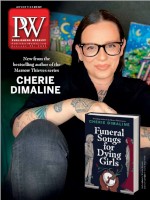Julie Flett has written and illustrated several picture books that reflect her Cree-Métis culture, including Birdsong, which won the 2020 TD Canadian Children’s Literature Award. She’s also illustrated numerous books by other Indigenous authors, including two Governor General’s Literary Award winners—When We Were Alone and On the Trapline, both written by David A. Robertson—and Just Like Grandma by Kim Rogers (Heartdrum, Jan.), which PW’s starred review said “emphasizes a love of family and sense of tradition.” Flett spoke with PW about sharing her heritage across generations.
How did you get started in your career?
My sister was working for Theytus Books, one of the first publishers of Indigenous voices in Canada. She asked me to draw the pictures for The Moccasins [by Earl Einarson, 2004]. I sent in sketches and three weeks later I turned in collage-based illustrations. I thought it was just for our community, but it made its way into libraries, and I’ve heard that many non-Indigenous kids have read it.
You often incorporate Mischif or Cree words into English text—why is that important to you?
I’m not a speaker, but my grandfather was. Once I asked him to speak to me in Cree and he started talking before all the words to my question were out of my mouth. There are few teaching books in Indigenous languages. I try to bring it in organically. In Birdsong, a neighbor tells a girl about the waxing and waning of the moon. “We say it this way,” the girl responds. Kids can learn a few words and they get excited to know a new language or their own language. As I learn Cree, I’m starting to understand my dad more. He didn’t speak the language, but he carried its worldview with him.
What appealed to you about Just Like Grandma?
The content is just so tender. I love working on books about intergenerational relationships in this beautiful world that we share. That’s what makes this a profound story. I thought of all the grandmothers in my life and brought them into my work. Elders are so important to us, which is a universal theme.
Can you talk a bit about your artistic process?
You can’t always go to the places you’re illustrating, so I’ll find photos on the internet; it’s natural to pull colors from that. After a while, I realized that made sense, to respond to where the characters are from. It’s a lovely way to start. I have a background in fine arts, not illustration. Paring an image to its essence is something that I developed over time. My first books, I wasn’t as happy with. Now I find connection with the heart of the story: it’s about saying a lot with very little.
What do you find most satisfying about your work?
I love the connections books make with kids—it’s the best. I love how engaged they are and the questions they ask. I had one boy, who was really shy, speak to me after I read Birdsong and tell me his favorite bird. I was a shy kid, so I love when my work opens up the shy kids.
Patricia Buckley, who is Mohawk from the Kahnawá:ke Reserve, is the author of the forthcoming early reader The First Woman Cherokee Chief, illus. by Aphelandra Messer (Random House, Feb.).



 Volume 270
Issue 4
01/23/2023
Volume 270
Issue 4
01/23/2023





